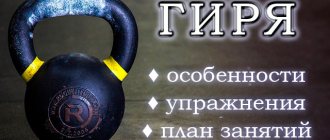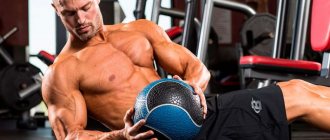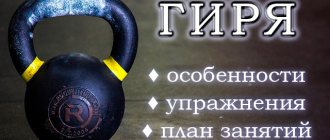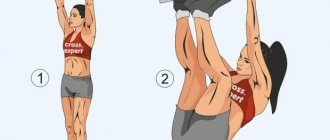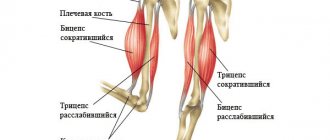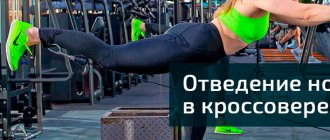Kettlebell swings, especially heavy ones, are a powerful exercise that develop explosive power and strengthen the muscles of the hips, back and buttocks. It is used by strength athletes to help develop proper pelvic motion for exercises such as squats or barbell lifts. Swings are also used in training athletes whose activity involves a large load on the thigh muscles.
In addition to the above, exercises with kettlebells are also used in such a discipline as CrossFit. Swings with a kettlebell can be performed with each hand alternately, with interceptions, or holding the projectile with both hands.
What muscles are used by the kettlebell swing?
As mentioned earlier, kettlebell swings load all muscles, but the main working horses are the legs and buttocks.
- Gluteus maximus muscle . It is the contraction of this muscle that is the main driving force for the weight, since the gluteus maximus is responsible for extension at the hip joint. It also performs a stabilizing function, keeping the back straight.
- Biceps femoris. The second of the main muscles that sets the acceleration for the kettlebell swing. It also extends the leg at the hip joint and stabilizes the knee joint.
- Quadriceps. Its role is significantly less than that of the other two muscles. It is more of a stabilizer. But even its small participation helps to add speed to the projectile.
The upper muscles are responsible for stabilizing the torso, adjusting the trajectory of the projectile and its retention. They also reduce the speed of its fall, which helps avoid injury during execution. This includes the pecs, lats, deltoids, rotator cuff, forearms, trapezius, rhomboids, and serratus.
Benefits of this exercise
- Kettlebell swings can develop muscles throughout the body. We are not talking about building mass; for this, of course, you need to perform specialized exercises. But if you work with weights on a regular basis, then you can count on your muscles becoming more powerful and stronger.
- Strengthens the hip joint, thighs and gluteal muscles. Together, their development will allow you to increase working weights in such basic exercises as SQUATS, ROMANIAN DEADLIFT and DEADLOAD.
- An excellent replacement for cardio. Working with a kettlebell in a swing style forces the cardiovascular system to work just like running or riding an exercise bike. So, if you want to increase your endurance and burn calories at the same time, then swings will be a good weapon in this matter.
- Improved coordination. Swings require coordinated actions from the athlete, otherwise injuries cannot be avoided. Many people involved in CrossFit use this exercise as an alternative to the Olympic bench press.
- Availability. Almost every Soviet athlete used to have a kettlebell at home. It doesn't take up much space and is quite easy to work with. Of course, if you want to increase the weight, you will have to purchase a heavier projectile.
Execution technique
The swing technique is not complicated, but you still need to approach it responsibly. The main thing to remember is one important rule: “The lifting of the weight does not occur due to the work of the deltoids, but with the help of acceleration that is created by the gluteal muscles and hamstrings.” If you master it, it will be easier for you to understand the mechanics.
Initial position:
- Take the right size kettlebell based on your fitness level and place it on the floor in front of you. Athletes who are performing this exercise for the first time can work without weight at the initial stage.
- Place your feet slightly wider than shoulder-width apart. Turn your feet out to the side towards your knees. We shift the center of gravity to the heels, but do not open the toes from the floor.
- We move our pelvis back, bend our legs at the knee joints and lean forward, while keeping our back straight.
- We grab the eye of the weight with both hands, palms facing the legs.
- We bring the shoulder blades together by contracting the rhomboid muscles.
- We tense our abdominal muscles.
- The gaze is directed forward.
Performance:
- You can immediately take the weight back from the starting position by passing it between your legs. Or we stand in a straight stance, lifting the apparatus from the floor and from this position we begin to perform the exercise. See for yourself how it’s easier for you. In this article, we will consider the option from the floor.
- From the starting position, we tear off the weight and move it back by the hips. During this movement, a slight tilt of the body forward is allowed, but the back must remain straight.
- As soon as the weight begins to move forward by inertia, we straighten the pelvis and knees, pushing it forward, while exhaling.
- At the moment of pushing out, we shift the center of gravity from the heels to the center of the foot, as when jumping forward from a place.
- This force should be enough to lift the weight up to approximately chest or chin level.
- Now it is important to do everything in reverse order. By inertia, the weight will begin to fall down, at this moment we begin to move the pelvis back, bending our knees a little and tilting the body forward, taking a breath.
- As soon as the forearms touch the inner thighs, and the projectile moves forward again by inertia, we again push it up, making a swing.
Recommendations for implementation
- Although the exercise is classified as inertial, your movements should still be smooth and controlled. It is not the weight that controls you, but you that controls it.
- Do not bend your knees too much in the starting position. This will turn your swing into a mixture of Goblet Squats and FRONT ARM RAISE. Our task is to set the acceleration of the projectile and control its movement.
- While lifting the weight, do not lean back, as this may cause you to lose your balance and further fall.
- Don't lift your heels off the floor. Shifting the center of gravity to the toes can also cause a loss of balance, and at the moment of lifting the weight will pull you along with it.
- Don't lean forward too much. This position will not allow you to make a maximum push with your glutes and muscles. In the worst case scenario, the weight will hit the floor.
- Do not round your back both in the initial phase (dumbbell abduction) and in the final phase (lifting). This can lead to spinal injury.
- Your movements must be clearly coordinated. If at the moment when the weight goes down you do not begin to move your pelvis, then it will pull you along with it. This can lead to injury to the rotator cuff or deltoid muscles.
How can a beginner learn to perform kettlebell swings correctly?
For an experienced athlete, mastering a new exercise will not be difficult, but for beginners it can be a problem. Firstly, their joints are not as flexible. Secondly, you first need to learn how to squat correctly. And ultimately, you should understand the biomechanics of the exercise, that is, perform swings using the muscles of the posterior chain. Some basic exercises can help us with this.
- Squats on a box or bench. By doing them, you will learn to correctly distribute the center of gravity by shifting it to the heels. The squat begins not with bending the knees, but with moving the pelvis back. This exercise will teach you how to squat correctly.
- Jumping onto a box or jumping from a sitting position. At this stage, it is important to master the work of the hip joint and engage the gluteal muscles to the maximum.
- Kettlebell swings on a towel. This is the last stage on the path to mastering the ideal technique. At the moment of the swing, the arms and the weight should be in the same plane. At the initial stage of mastering, the arms may involuntarily bend at the elbow and the shoulder joint will join in the movement. Working with a towel will make it easier to monitor the correct execution. If at the moment of the swing the weight and arms are in the same plane, then you are doing everything correctly.
It is also worth working on the flexibility of the hip joint. Therefore, at the end of your workout, you should definitely take some time to COOL UP and stretch your hips.
Common Mistakes
The exercise must be done strictly according to the rules. Otherwise, it will not be possible to achieve the desired result. In addition, instead of the expected benefit, physical activity can cause harm. It is worth considering the most common mistakes to avoid making them:
- Performing squat exercises follows the same principle as a squat.
- Flexion of elbows and hands.
- Lifting the projectile by tensing the deltoid muscles.
- Rounding the back.
- Relaxation of the abdomen.
- Insufficient hip work. The athlete tries to push the projectile out only by straightening his knees.
The main mistake that beginners make is replacing the kettlebell with some other type of weight. This exercise becomes ineffective in such a situation. Training will give the desired result only if you use the right sports equipment.
The problem is that a large assortment of equipment of different weights is presented only in gyms. Therefore, people try to replace them with improvised means, making a huge mistake. If you can't find the right equipment, it's better to do other strength training options. Once your physical fitness improves, you can return to swings using heavier kettlebells.
Rounding your back and relaxing your stomach are common mistakes when performing kettlebell swings.
It is incorrect to lift the apparatus by tensing the deltoid muscles
You cannot replace the kettlebell with other equipment; in this case, the exercise becomes ineffective.
Options for swings with a kettlebell
There are several varieties of this exercise.
- Swing kettlebells overhead. This option is better known as “American swings”. Western athletes love to perform this exercise in this style. That is, in the final phase of the exercise, the weight is not located in the area of the chest or chin, but almost above the head. This technique, according to these athletes, involves the shoulder joint in the work, which is essentially true. But at the same time, it can also cause injury. Therefore, if you decide to work in the so-called American style, then thoroughly stretch your shoulder joint.
- Lifting a kettlebell with one hand. The principle of execution remains the same, but now we work with each hand in turn. First, perform the required amount on the right, then on the left. Working in this style, we will shift the emphasis from one part of the gluteal to another. This will not only put more stress on them, but also create an imbalance in development. More experienced athletes can change hands during execution. That is, in the upper phase they throw the weight from one to another.
- Lifting two dumbbells. Another option that will allow you to complicate the basic version of the swings. Now we hold a weight in each hand, and when swinging we will have to not only concentrate on working the necessary muscles, but also coordinate the projectiles so that they rise at the same time.
Recommendations for creating a training program[edit | edit code]
Some authors recommend changing your kettlebell training cycles every two weeks.
Marty Gallagher said that an ideal year of strength training consists of two 12-week competition cycles (meeting in week 13) and two 12-week off-seasons where a variety of exercises are practiced.
Alexey Faleev, master of sports and author of popular fitness programs in Russia based on powerlifting, alternates 4-5 months of strength training with 4-5 months of dynamic training.
- Train with the kettlebell training initiation program for 12 weeks, then gradually move on to a more professional program
. - You can practice one-arm push-ups and other exercises with your own body.
- To improve general physical fitness, add jumping rope and/or sprint intervals to your workouts.
Here is the sprint interval
, proposed by the USSR snatch test record holder: “Once a week I train for a minute, then rest for a minute as follows. I set the treadmill at 8 mph and the incline at 12. I hop on the side rails, set my watch, wait for the watch to read 0:59, then run for exactly one minute. When the clock shows 1:59, I jump off and start walking around the room to catch my breath. After about 30 seconds, I walk back to the treadmill, stand on the side rails, wait for the clock to read 2:59 so I can jump into place and repeat the process eight times. The workout takes about 17 minutes, then I have a smoke break. My legs become wobbly and I begin to feel bouts of vomiting. Believe it or not, my jerks come easier. I really feel that in order to do 250 to 280 repetitions for ten minutes, a person must have good heart function. I'm not a big fan of cardio, but for hardcore kettlebell training, it's essential. To put it simply, I run once a week for a total of 8 minutes and it helps.”
Naturally, such training should be carried out three times a week only if you do not do swings and jerks.
Abs workout
- Do 3-5 x 3-5 oblique exercises on the first day, such as Tuesday.
- Perform exercises for the rectus abdominis muscle 3-5 x 3-5 on the second day, for example on Thursday.
- These exercises are done after deadlifts, if you are doing them.
Tips for maximum efficiency
- Before performing swings, you must complete a set of WARM-UP EXERCISES. In this case, it is worth paying attention to all joints, with an emphasis on the hip.
- Choose the correct projectile weight. This exercise does not require you to lift a 72kg kettlebell. In principle, you can’t find something like this in every room. The main task is placed on technology.
- If you feel that the basic version of the exercise is too easy for you, you can go in two ways: increase the weight of the kettlebell or try your hand at a more difficult option from the ones proposed above.
- If you have had injuries to your knees, back, hips or knees. Then, before you start performing swings, you should consult a doctor.
- It is best to master the technique under the supervision of an experienced mentor. If possible, find someone. This could be a coach or someone you know who is very familiar with the mechanics of this exercise.
I think this article helped you change your view of such a simple training equipment as a kettlebell. To fully experience the power of swings and their benefits, you just need to start doing them. Once you understand the technique, you will hardly be able to ignore this exercise any longer.
Good luck to everyone in your training!
Inclusion in the program
The exercise is included as the first if we have a beginner in front of us who is just learning the technique. It is believed that women should start learning it from 8 kg, and men from 16, but this is not a hard rule, but just a recommendation.
The exercise is not done in a multi-repetition mode at first, starting with 5-6 sets of 10-12 repetitions. Then you can switch to a more “aerobic” high-repetition mode and move more.
Often kettlebell exercises are performed not for repetitions, but according to a timer, this allows you to concentrate on technique, and not on counting the number of swings.
